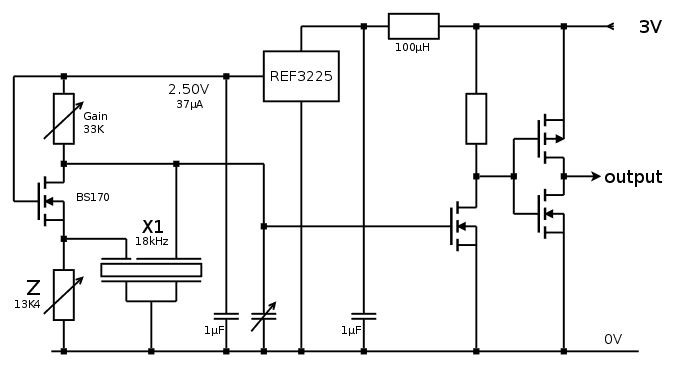The complete 18KHz clock source is there :

Now I must
- Build the prototype
- validate all the parts' values (easy)
- verify the frequency and tune oscillator to the best possible precision (but my Rb source fried and my DDS is far from alive :-( )
- place & route the PCB
- find a temperature controlled oven/freezer to plot the stability
Update (20160531): With the given resistor values and the REF3225, the oscillator starts within 30s, before fine-tuning !
However the output swing of the oscillator is too low (0.5V-1.5V) to properly trigger the first amplification stage. This is solved with a P-channel MOSFET instead of a N-channel :-)
Update (20160629) : the P-MOSFET works much better than the N-MOSFET but... new problems appear. I get really weird waveforms and interactions with the oscillator, some unexpected nasty (capacitive) coupling must be at work.
The ideal solution would be a JFET but this is "not kosher" for this project, I have to manage amplification with a very high input impendance and low input capacitance.
In the #Active scope probe with no dedicated power supply project, I evaluate differential amplifiers but they use JFET at the input and probably draw more than the 37µA of the primary oscillator.
How can I shield the primary osc. from the gate capacitance of the amplifier ? @K.C. Lee suggested in a previous log (https://hackaday.io/project/9376-yet-another-discrete-clock/log/32117-crystal-oscillator-with-complementary-mosfets) to add a 100K series resistor.
The bias is another issue : what is best for the oscillator is not best for the amplifying stage. A capacitive coupler is required, driving a self-biased NOT gate (P & N-MOSFET). Additional resistors at both sources might further shield from capacitances... The first stage will end up with 4 resistors, 2 FET and 1 capacitor. The coupling capacitor must be around 1nF, which gives a RC time of about 100µs, or 10KHz.
The NOT gate could be preceded by a common-drain amplifier (?) or one of the circuits described in this "booster" article.
Sorry, no drawing yet because (oh well, don't get me started)
 Yann Guidon / YGDES
Yann Guidon / YGDES
Discussions
Become a Hackaday.io Member
Create an account to leave a comment. Already have an account? Log In.